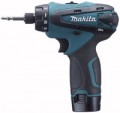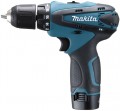Product type
General type of instrument.
Nowadays, several other types of hand tools are also combined into one category with traditional
drills, with a similar design and principle of operation:
drill drivers, classic
screwdrivers,
wrenches and
electric screwdrivers. Here is a detailed description of each of these varieties:
— Drill. Traditional drills are power tools for drilling holes in various materials. By specialization and “weight category”, such tools range from miniature cordless models to heavy professional diamond drilling units (see “Intended Use”). Anyway, drills are equipped with chucks for installing drills, as well as engines designed for significant resistance during operation. Also note that many of these units have an impact mode, but the drill is still not able to replace a full-fledged rotary hammer (for more details, see "Functions").
— Screwdriver. In fact, it is an electric (or pneumatic) analogue of a manual screwdriver. It is used primarily for tightening and loosening screws, screws and other similar fasteners using bits — interchangeable nozzles, the shape of which imitates various screwdriver tips (straight, cross-shaped, etc.). Accordingly, the standard type of retainer for the nozzle in such a tool is for a bit (see "Chuck Type"). Screwdrivers differ from electric
...screwdrivers (see below) in higher power, better suitability for long-term work and high loads, as well as larger dimensions and rather significant (in comparison, of course) weight.
— Drill driver. Tools (mainly cordless, see "Power source") that combine the functionality of a drill and a screwdriver. See above for more on both, and these "hybrid" devices are extremely popular these days due to their versatility. Switching between drilling and twisting modes in them is carried out by changing the cartridge, and also, in most models, by adjusting the torque (see below). At the same time, it should be noted that compared to traditional drills, the efficiency of such units when drilling is rather low, they are not intended for high loads, hard materials and large drilling diameters. This is due to the fact that in order to achieve high power, it would be necessary to increase the dimensions and weight, which would significantly complicate the use in the format of a screwdriver.
— Screwdriver. A kind of electric and pneumatic analogues of socket wrenches: tools designed to work with nuts and other similar fasteners (for example, bolts with heads without a slot). Nutrunners are in many ways similar to the screwdrivers described above and differ mainly in the type of cartridge — usually it is a square for sockets of different sizes.
— Screwdriver. An electrical analogue of a conventional manual screwdriver (pneumatic drive is not used in such devices for a number of reasons). Some of these models have a straight body shape (see "Construction") and are very similar in appearance to hand tools; others resemble smaller and lighter screwdrivers (see below). Anyway, electric screwdrivers are intended mainly for work where accuracy and accuracy are more important than high efforts (or where these efforts are simply not required). Thus, the low power of such devices is not so much a disadvantage as a feature. In addition, this feature allows you to use battery power without much difficulty, making the tool as autonomous as possible; in fact, electric screwdrivers with mains operation nowadays are almost never found. And the small size and weight, in turn, contribute to the mentioned accuracy and accuracy.Weight
The total weight of the tool is usually the device itself, without attachments. For battery models (see "Power Source"), usually, the weight is indicated with a standard battery installed; for battery-powered models, the weight can be given both with and without batteries, but in this case this point is not particularly important.
Other things being equal, less weight simplifies work, increases accuracy of movement and allows you to use the tool for longer without tiring. However, note that high power and productivity inevitably increase the mass of the tool; and various tricks to reduce weight increase the price and can reduce reliability. In addition, in some cases, a massive design is more preferable. First of all, this applies to work with a large load — for example, drilling holes of large diameter, or making recesses with impact: a heavy tool is more stable, it is less prone to jerks and shifts due to uneven material, vibration of mechanisms, etc.
It is also worth noting that specific weight values are directly related to the type of tool (see "Device"). Screwdrivers are the lightest — in most of them this figure
does not exceed 500 g. Screwdrivers and drill drivers are more "heavy": their average weight is
1.1 – 1.5 kg, although there are many lighter (
0.6 – 1 kg) and heavier (
1.6 – 2 kg or more ) models. And clas
...sic drills and wrenches have the greatest weight: such a tool must be quite powerful, so for them 1.6 – 2 kg is an average, 2.1 – 2.5 kg is above average, and many units weigh more than 2, 5 kg.Chuck type
Two points depend on the type of cartridge: the types of working tools (drills, screwdrivers, etc.) with which this or that model is compatible, and the method of installing / removing them.
—
Key. As the name implies, you will need a special key to work with such a cartridge. The mount itself is usually designed for tools with round shanks (mostly drills) and includes three cams that, when clamped, converge towards the centre, clamping the tool installed in the chuck on the axis of rotation. The main disadvantage of this type of cartridge is the need to use a key: it can be lost and the mount becomes useless. In addition, installing and removing a working tool can be quite a long process. However, the keyed chuck is considered somewhat more reliable than the keyless chuck and more suitable for heavy work.
—
Quick release. Similar to the keyed chuck described above, this type of chuck is designed primarily for drills with round shanks. Its main difference is the absence of a key — you can fix or remove the drill with the help of a hand, without any additional tools. Such chucks are slightly less suitable for work with high loads (for example, in hard materials and/or with large diameter drills), but otherwise they do not lose in any way with the key, and in terms of ease of use they are significantly superior.
—
Under the beat. Bits are working tool
...s used in screwdrivers and screwdrivers (see "Device"). The working side of the bit can have a flat, cruciform or other shape (star, trihedron, etc.), but the shank with which it is fixed in the cartridge is standardly made hexagonal. Accordingly, the bit chuck has a recess for such a shank. Fixation can be carried out mechanically, in the form of a simple latch, or with a magnet; in both cases, the mount is secure enough for safe operation, and the tool can be removed without much effort.
— Morse taper. A cartridge for one of the varieties of the tool cone — the so-called Morse cone. As the name implies, this mount involves a conical shank and a corresponding hole for it (often with an additional groove for the protrusion on the shank — for secure fixation and prevention of rotation). This option is found mainly in drills (see "Device"). Note that the Morse cone is available in several sizes that are incompatible with each other.
— Square. The type of chuck used in impact wrenches. Unlike all other varieties, the working tool for the “square” is not installed inside the cartridge, but is put on it from the outside. Squares can have several standard sizes, but these sizes are the same for both electric and hand tools. In fact, this means that nozzles from manual wrenches can also be used in electric models if the landing size is the same (and if not the same, you can use an adapter, although this is less convenient).
— None (threaded spindle). The absence of a cartridge as such: a thread located directly on the spindle is used to fasten the working nozzles. Almost all models with this feature are powerful professional tools designed for diamond drilling (see "Intended use") — for a number of reasons, it is the threaded spindle that is considered the best way to attach nozzles for such drilling. Note that the thread on the nozzle can be both external and internal; most spindles are compatible with both varieties, but there are exceptions. So this nuance needs to be specified separately.
Note that in some models two types of cartridges can be combined — for example, for a bit and quick-clamping. Usually, for this, the kit provides two different cartridges that can be changed as needed, but there are other options — for example, a spindle into which you can insert both a bit and a drill chuck (key or keyless). Anyway, this makes the tool more versatile and allows you to work with numerous working attachments.Chuck diameter
The nominal diameter of the chuck supplied with the tool.
This size is indicated by the maximum diameter of the drill (or bit shank) that can be installed in the fixture. There are several standard sizes; the most popular nowadays are
the 10 mm cartridge and the 13 mm cartridge ;
drills with a 16 mm chuck are noticeably less common, as well as miniature mounts
less than 10 mm(usually 8 mm or 6 mm).
The larger the drill, the more power is required for its efficient use; accordingly, larger cartridges are characteristic of heavier and more powerful tools. At the same time, it is quite possible to install a smaller cartridge on the drill, if the possibility of replacement is technically provided for at all. But the possibility of working with larger fasteners (and drills for them) should be clarified separately: not every tool has enough power for this.

